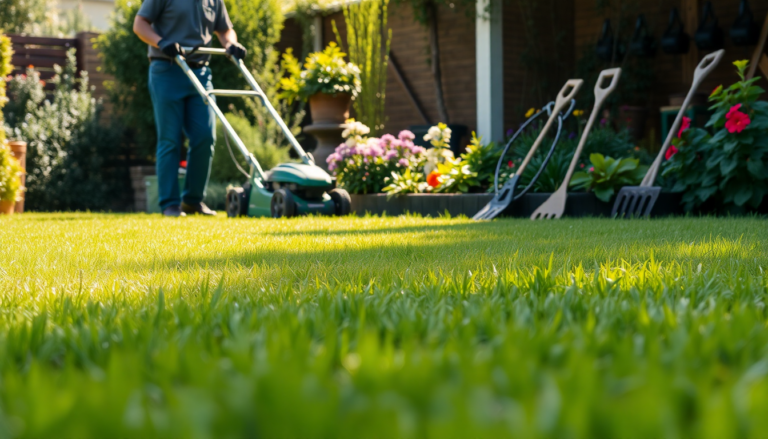Argomenti trattati
Understanding your lawn’s needs
Taking care of your lawn can sometimes feel like a daunting task. Many people start with good intentions but end up making mistakes that can harm their grass. One important thing to remember is that lawn care requires a keen understanding of your specific environment and grass type. As Clint Waltz, a turfgrass extension specialist, suggests, while you can’t control weather extremes, you can make informed choices about fertilization and mowing that directly impact your lawn’s health.
Healthy grass is not only visually appealing but also more resilient against challenges such as drought, pests, and diseases. Peter Landschoot, a turfgrass science expert, emphasizes the importance of setting realistic expectations for your lawn care efforts. Striving for perfection can lead to disappointment and frustration, so focus on nurturing your lawn to make it thrive.
Common lawn care mistakes to avoid
There are several pitfalls that many homeowners fall into when caring for their lawns. Below are some of the most common mistakes that can lead to unintentional ‘lawn-slaughter’ and how to rectify them.
Neglecting pre-emergent treatments
One of the most significant oversights is failing to use a pre-emergent herbicide. Weeds can quickly take over if not addressed, as they compete with your grass for vital resources. According to Waltz, if you ignore weeds, they will multiply, leading to a lawn that’s more weeds than grass.
Solution: Apply a pre-emergent product before weeds can germinate. Ensure you choose the right type of pre-emergent suitable for your grass type. If you’re unsure about your grass, consult with your local agricultural extension service.
Applying treatments too late
Timing is critical when it comes to applying pre-emergent treatments. If the application occurs after soil temperatures reach about 55 degrees Fahrenheit, you risk allowing weeds to sprout. Tracking soil temperatures rather than relying solely on the calendar is essential.
Solution: Monitor soil temperatures and apply your products before reaching the critical threshold.
Misusing organic products
While organic weed killers might seem like a safer option, many are non-selective and will harm your grass as well. These products often require frequent applications since they do not work systemically within plants.
Solution: Use organic products with caution and understand they may not be effective against all weed types. Regular reapplication may be necessary to manage weeds.
Over-relying on irrigation systems
Setting a timer for your irrigation system can be convenient, but these systems often don’t account for environmental changes like rainfall and humidity. Overwatering not only wastes resources but can also harm your lawn.
Solution: Water only when your grass shows signs of needing it, such as a bluish tint or wilting. Early morning watering is ideal to minimize evaporation.
Ignoring crabgrass management
Crabgrass may disappear in the fall, but if it’s not managed, it can return with a vengeance in the spring. The seeds can lie dormant for years, just waiting for the right conditions to germinate.
Solution: Implement annual pre-emergent treatments in areas where crabgrass has previously been an issue.
Best practices for lawn care
Aeration, fertilization, and proper mowing techniques are foundational to maintaining a healthy lawn.
The importance of aeration
Aeration enhances soil health by creating air pockets for grass roots to access nutrients and moisture. If your lawn has heavy foot traffic, consider core aeration to improve growth.
Solution: Aerate your lawn once a season, especially if it’s compacted. Conduct this when your grass is actively growing for the best results.
Effective fertilization
Fertilization is vital for your lawn’s health, as it replaces essential nutrients. A lawn that isn’t fertilized after three years can decline significantly.
Solution: Follow the recommended application rates on fertilizer labels. Even on a budget, applying a conservative amount will help sustain grass health.
Reading product labels
Understanding how much product to use is crucial to avoid over-application, which can lead to pollution and waste.
Solution: Utilize tools like Google Earth to measure your lawn’s square footage and apply products accordingly. Properly using your spreader can also help minimize waste.
Recognizing signs of distress
Your lawn won’t tell you when something is wrong, so it’s essential to be observant. Changes in color or the presence of moss can indicate underlying issues.
Solution: If you notice unusual signs, reach out to local experts for advice and solutions before conditions worsen.
Proper mowing techniques
Mowing too short can severely damage your lawn by preventing it from optimizing water absorption. Conversely, infrequent mowing can lead to unsightly clumps of grass.
Solution: Familiarize yourself with the ideal mowing height for your grass type and mow as needed, ensuring to maintain a healthy balance.

